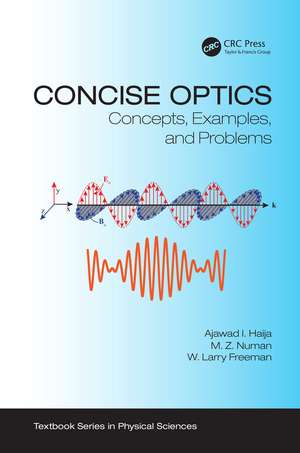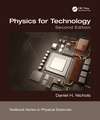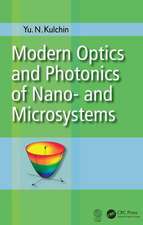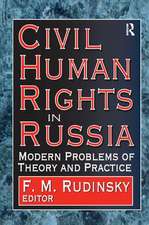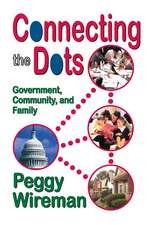Concise Optics: Concepts, Examples, and Problems: Textbook Series in Physical Sciences
Autor Ajawad I. Haija, M. Z. Numan, W. Larry Freemanen Limba Engleză Paperback – mar 2018
Ajawad I. Haija is a professor of physics at Indiana University of Pennsylvania.
M. Z. Numan is professor and chair of the department of physics at Indiana University of Pennsylvania.
W. Larry Freeman is Emeritus Professor of Physics at Indiana University of Pennsylvania.
| Toate formatele și edițiile | Preț | Express |
|---|---|---|
| Paperback (1) | 705.53 lei 43-57 zile | |
| CRC Press – mar 2018 | 705.53 lei 43-57 zile | |
| Hardback (1) | 1800.94 lei 43-57 zile | |
| CRC Press – 13 mar 2018 | 1800.94 lei 43-57 zile |
Preț: 705.53 lei
Preț vechi: 830.03 lei
-15% Nou
Puncte Express: 1058
Preț estimativ în valută:
135.05€ • 146.74$ • 113.51£
135.05€ • 146.74$ • 113.51£
Carte tipărită la comandă
Livrare economică 21 aprilie-05 mai
Preluare comenzi: 021 569.72.76
Specificații
ISBN-13: 9781138107021
ISBN-10: 1138107026
Pagini: 486
Ilustrații: 8 Tables, black and white; 220 Illustrations, black and white
Dimensiuni: 156 x 234 x 25 mm
Greutate: 0.66 kg
Ediția:1
Editura: CRC Press
Colecția CRC Press
Seria Textbook Series in Physical Sciences
ISBN-10: 1138107026
Pagini: 486
Ilustrații: 8 Tables, black and white; 220 Illustrations, black and white
Dimensiuni: 156 x 234 x 25 mm
Greutate: 0.66 kg
Ediția:1
Editura: CRC Press
Colecția CRC Press
Seria Textbook Series in Physical Sciences
Public țintă
UndergraduateCuprins
Series Preface: Textbook Series in Physical Sciences
Preface
Acknowledgments
Authors
Section I — Introduction
Chapter 1. Light: Its Nature and History of Study
Section II — Geometrical Optics of Light
Chapter 2. Reflection and Refraction
Chapter 3. Paraxial Rays and Lenses
Chapter 4. Matrix Optics for Paraxial Rays
Section III — Wave Optics
Chapter 5. Light Waves, Properties, and Propagation
Chapter 6. Light Waves, Coherence, Superposition, and Interference
Chapter 7. Double and Multiple-Beam Interference
Chapter 8. Diffraction I: Fraunhofer Diffraction
Chapter 9. Diffraction II: Fresnel Diffraction
Chapter 10. Optics of Multilayer Systems
Chapter 11. Polarization
Chapter 12. Fourier Optics
Chapter 13. Photonics
Appendix A: Trigonometry
Appendix B: Complex Numbers
Appendix C: Mathematical Operators—Cartesian and Spherical Coordinates
Appendix D: Matrices
Appendix E: Physical Constants
Appendix F: Examples on Fresnel Diffraction Done on Mathematica
Appendix G: Solutions of Selected Examples from Chapter 10 Using Excel
Bibliography
Index
Preface
Acknowledgments
Authors
Section I — Introduction
Chapter 1. Light: Its Nature and History of Study
Section II — Geometrical Optics of Light
Chapter 2. Reflection and Refraction
Chapter 3. Paraxial Rays and Lenses
Chapter 4. Matrix Optics for Paraxial Rays
Section III — Wave Optics
Chapter 5. Light Waves, Properties, and Propagation
Chapter 6. Light Waves, Coherence, Superposition, and Interference
Chapter 7. Double and Multiple-Beam Interference
Chapter 8. Diffraction I: Fraunhofer Diffraction
Chapter 9. Diffraction II: Fresnel Diffraction
Chapter 10. Optics of Multilayer Systems
Chapter 11. Polarization
Chapter 12. Fourier Optics
Chapter 13. Photonics
Appendix A: Trigonometry
Appendix B: Complex Numbers
Appendix C: Mathematical Operators—Cartesian and Spherical Coordinates
Appendix D: Matrices
Appendix E: Physical Constants
Appendix F: Examples on Fresnel Diffraction Done on Mathematica
Appendix G: Solutions of Selected Examples from Chapter 10 Using Excel
Bibliography
Index
Notă biografică
Ajawad I. Haija attended the University of Alexandria in Egypt, where he received his B.Sc. degree in 1968 with distinction, first honor. He received his Ph.D. (1971-1977) at Pennsylvania State University in 1977. In 2000, he moved to the United States and joined the Indiana University of Pennsylvania. He is currently on the physics faculty, where he conducts research on the properties of thin multilayer structures and super-lattices. In 2014 Dr. Haija was awarded the Distinguished Faculty Award for Teaching, 2013–2014, Indiana University of Pennsylvania, IUP. A. J. Haija is a former member of New York Academy of Sciences and a current member of the American Physical Society.
M. Z. Numan hails from Bangladesh, where he received his B.Sc. (Hons.) and M.Sc. degrees in physics from Dhaka University. He received his Ph.D. from The College of William and Mary in Virginia in 1982. He taught at Virginia Commonwealth University in Richmond, Virginia, University of North Carolina at Chapel Hill, and Indiana University of Pennsylvania, where he is currently the chair of the department of physics. His research focused on materials modification and characterization using ion implantation, back scattering and channeling; optical and electrical characterization of metallic multi-layers and semiconductor materials; light harvesting through silicon micro and nano structures.
W. Larry Freeman was born and grew up in South Carolina, USA, and earned his B.Sc. in physics from Appalachian State University in 1969. Dr. Freeman received his Ph.D. From Clemson University in 1976 where his dissertation explored quantum size effects in thin Bismuth films at low temperatures. After leaving Clemson University and teaching high school and technical college, he returned to Clemson on a post-doctoral position. He joined the US Naval Intelligence service in 1978, and was moved to the US Army Night Vision and Electro-Optics Laboratory in 1980 where he was heavily involved with the development of solid-state materials used for the detection of radiation in the infrared radiation wavelength range. He was instrumental in developing nondestructive testing and characterization as well as fabrication techniques for the manufacturing of solid-state infrared detector arrays.
Dr. Freeman moved to Indiana University of Pennsylvania in 1984 where he taught graduate and undergraduate courses in physics. He retired from IUP in 2010 and currently holds the position of Emeritus Professor of Physics. He maintains his memberships in the American Physical Society and American Association of Physics Teachers.
M. Z. Numan hails from Bangladesh, where he received his B.Sc. (Hons.) and M.Sc. degrees in physics from Dhaka University. He received his Ph.D. from The College of William and Mary in Virginia in 1982. He taught at Virginia Commonwealth University in Richmond, Virginia, University of North Carolina at Chapel Hill, and Indiana University of Pennsylvania, where he is currently the chair of the department of physics. His research focused on materials modification and characterization using ion implantation, back scattering and channeling; optical and electrical characterization of metallic multi-layers and semiconductor materials; light harvesting through silicon micro and nano structures.
W. Larry Freeman was born and grew up in South Carolina, USA, and earned his B.Sc. in physics from Appalachian State University in 1969. Dr. Freeman received his Ph.D. From Clemson University in 1976 where his dissertation explored quantum size effects in thin Bismuth films at low temperatures. After leaving Clemson University and teaching high school and technical college, he returned to Clemson on a post-doctoral position. He joined the US Naval Intelligence service in 1978, and was moved to the US Army Night Vision and Electro-Optics Laboratory in 1980 where he was heavily involved with the development of solid-state materials used for the detection of radiation in the infrared radiation wavelength range. He was instrumental in developing nondestructive testing and characterization as well as fabrication techniques for the manufacturing of solid-state infrared detector arrays.
Dr. Freeman moved to Indiana University of Pennsylvania in 1984 where he taught graduate and undergraduate courses in physics. He retired from IUP in 2010 and currently holds the position of Emeritus Professor of Physics. He maintains his memberships in the American Physical Society and American Association of Physics Teachers.
Recenzii
"a comprehensive text… at the right level for our students and brings together ideas from other undergraduate courses to explain the basic fundamentals of optics…. There are quite a few helpful worked out examples as well as good homework problems included."
--Matthew M. Waite, West Chester University of PA
"There are a number of introductory/undergraduate optics books in the market...What is different about this book is that the whole gamut of introductory optics can be covered in one semester, as only the basic essentials of each topic are covered. The prerequisites assumed are rather minimal—introductory physics and basic calculus. The appendices cover other requisite math such as complex numbers, volume integrals and matrices. What is surprising (and not usually found in introductory texts) is the rather extensive discussion on calculating the Cornu spiral. Also presented is the appropriate Mathematica code. The other topic not usually encountered is the characteristic-matrix technique for dealing with thin films and layer stacks...The book is ideal either for use in the classroom or for self-study."
--Vengu Lakshminarayanan, University of Waterloo, Canada
--Matthew M. Waite, West Chester University of PA
"There are a number of introductory/undergraduate optics books in the market...What is different about this book is that the whole gamut of introductory optics can be covered in one semester, as only the basic essentials of each topic are covered. The prerequisites assumed are rather minimal—introductory physics and basic calculus. The appendices cover other requisite math such as complex numbers, volume integrals and matrices. What is surprising (and not usually found in introductory texts) is the rather extensive discussion on calculating the Cornu spiral. Also presented is the appropriate Mathematica code. The other topic not usually encountered is the characteristic-matrix technique for dealing with thin films and layer stacks...The book is ideal either for use in the classroom or for self-study."
--Vengu Lakshminarayanan, University of Waterloo, Canada
Descriere
This introductory text is a reader-friendly treatment of geometrical and physical optics emphasizing problems and solved examples with detailed analysis and helpful commentary. The book covers ray tracing to the wave nature of light, and introduces Maxwell’s equations in an organic fashion.
